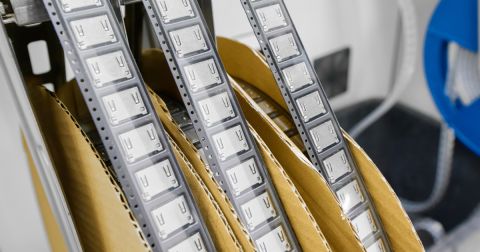Altium Develop BOM Management Tools: A Game Changer for Electronics Design and Supply Chain Optimization

Managing PCB (Printed Circuit Board) project Bills of Materials (BOMs) using manual methods, such as spreadsheets, is still a common practice for many electronics design teams. However, these traditional approaches are fraught with issues that can have serious implications for the success of design projects. Relying on manual tools for BOM management introduces inefficiencies, risks, and miscommunication that can delay production, inflate costs, and even result in non-compliant or obsolete products. Smart BOM management tools that are integrated in your ECAD software with up-to-date supply chain data can accelerate electronic product development and reduce time-to-market.
The Challenges of Manual Electronics BOM Management
- Prone to Human Error: Spreadsheets, while flexible, are highly prone to human error. A simple mistake—such as a wrong part number, incorrect quantity, or outdated supplier information—can cause costly disruptions further down the production line. These errors are often only discovered late in the process after significant time and resources have been invested.
- Lack of Real-Time Data: Manual BOMs do not integrate real-time supply chain data, meaning engineers and procurement teams are often working with outdated component lifecycle management information regarding component availability, pricing, and compliance. This disconnect can result in unexpected shortages, extended lead times, or unforeseen price hikes that disrupt the project schedule and budget.
- Inefficient Communication: BOMs managed through static files are often shared through email or other ad hoc methods, leading to version control issues and miscommunication between teams. This can create confusion, as stakeholders may work from outdated BOMs, increasing the risk of inconsistencies between the design and procurement stages.
- Difficulty in Managing Compliance: Ensuring that all components meet regulatory standards like REACH or RoHS is a time-consuming, manual task. Without automated tracking, teams must regularly check component compliance status, risking the use of non-compliant parts that can delay product approval or require redesigns.
- Inability to Track Component Lifecycles: In a rapidly evolving electronics market, components can quickly become obsolete or move into end-of-life (EOL) status. Manual component lifecycle management methods do not provide automatic alerts when a component is no longer viable, which can result in last-minute redesigns or delayed production runs.
- Reactive Problem Solving: Without the ability to proactively monitor supply chain risks or address component issues early, teams are often forced into a reactive mode. This can lead to rushed decisions, higher procurement costs, and compromised product quality as engineers scramble to find suitable alternatives or pay premiums to meet deadlines.
These issues combine to create significant inefficiencies in the design and manufacturing process. In an industry where time-to-market is crucial, the risks associated with manual BOM management can result in lost competitive advantage, higher production costs, and dissatisfied customers.
Altium Develop PCB BOM Management: A Comprehensive Solution for PCB Design and Supply Chain Optimization
Altium Develop BOM management tools address the challenges of manual BOM management by providing an up-to-date, integrated solution that enhances collaboration between design and procurement teams. By automating data entry, integrating live supply chain information, and offering advanced BOM analysis features for tracking component availability, managing compliance, and proactively identifying risks, Altium Develop BOM management software helps design teams avoid costly mistakes, accelerate time-to-market, and maintain product quality.
With its ability to connect design, procurement, and compliance data, Altium Develop delivers the latest insights that optimize supply chain strategies, reduce costs, and improve overall product reliability. As PCB design grows in complexity, transitioning from manual methods to a comprehensive BOM software solution is essential is electronics design companies are to stay competitive in today’s electronics market.
What Are Altium Develop BOM Management Tools?
Altium offers an all-in-one interface for creating, managing, and analyzing BOMs in real time, integrated into your electronic design automation platform. The platform's BOM software combines detailed component data, supply chain insights, and procurement metrics, empowering engineers to make better decisions during the design process. Electronics BOM capabilities are found in several key panels:
- Main View Panel: Provides a clear snapshot of component data, including part numbers, manufacturer lifecycle, and status.
- Supply Chain Panel: Displays supply chain data such as pricing, availability, and lead times, based on the quantity of components required for both prototyping and production.
- Issues Panel: Identifies potential risks, like obsolete or non-compliant components, and helps engineers resolve these before they become bottlenecks.
- Release Panel: Simplifies BOM revisions and sharing across teams, supporting both internal and external collaboration.
- Dashboard Panel: Offers a comprehensive overview of BOM health, manufacturability, and procurement risks in a single location.

Why Altium Develop Is Essential for Design Engineers
- Faster, Smarter BOM Management: Altium Develop BOM Management allows engineers to manage and edit BOMs with the flexibility of a spreadsheet while integrating advanced document control and collaboration features. This streamlined interface improves accuracy and speeds up the BOM creation process, allowing teams to move seamlessly from design to procurement.
- Real-Time Supply Chain Intelligence: The portal integrates enriched supply chain data, enabling engineers to monitor component availability, pricing fluctuations, and lead times. With this visibility, teams can make informed component lifecycle management decisions and select components based on cost, availability, and compliance, ensuring their designs remain viable through both prototype and production phases.
- Early Issue Detection and Resolution: The Issues Panel proactively flags components that are end-of-life, non-compliant, or have extended lead times. This early warning system allows engineers to resolve issues before they escalate, minimizing production delays and ensuring components meet all necessary standards.
- Optimized Component Sourcing: Engineers can leverage BOM tools to source components from approved vendors, ensuring they receive the best possible prices without compromising on quality or lead times. By analyzing vendor coverage and stock availability, the portal helps teams make smarter sourcing decisions and avoid procurement bottlenecks.

- ECAD Software Integration: BOM management tools are available in and tightly integrated with electronics designers’ ECAD software. Engineers can manage electronics BOMs directly within their familiar design environment. Seamless integration eliminates the need to switch between multiple applications, reducing data entry errors and ensuring that design changes are automatically reflected in the BOM.
Ensuring Supply Chain Stability and Efficiency
- Competitive Vendor Selection: Altium Develop BOM management software helps teams source components from a curated list of approved vendors, ensuring that pricing remains competitive and suppliers are reliable. By integrating real-time supply chain data, engineers can evaluate and choose the best sourcing options, optimizing both cost and availability.
- Guaranteed Component Availability: With instant access to vendor stock levels, the portal ensures that teams can verify component availability in the right quantities, at the right price, and within the required time frame. This real-time information helps prevent shortages and ensures that designs stay on track from prototyping to full-scale production.
- Early Identification of Supply Chain Risks: BOM analysis continuously monitors supply chain health, alerting engineers to potential issues such as extended lead times or vendor shortages. By addressing these risks early, teams can mitigate delays and keep production schedules intact.
- Regulatory Compliance Made Simple: Ensuring compliance with standards such as REACH and RoHS is critical in modern electronics design. Non-compliant components are flagged automatically, helping teams quickly replace them with alternatives that meet regulatory requirements. This not only minimizes risk but also ensures products are market-ready and sustainable.

How Altium Develop BOM Management Transforms the Design-to-Production Process
- Accelerated Time-to-Market: Integrating supply chain data directly into the design process helps engineers make faster, more informed decisions. Early collaboration between design and procurement teams ensures that part specifications, availability, and pricing are aligned from the start, speeding up the overall product development cycle without sacrificing quality.
- Proactive Supply Chain Management: With real-time tracking of part lifecycles and availability, the portal ensures that engineers stay ahead of supply chain fluctuations. By continuously monitoring part availability and lead times, teams can adjust designs or sourcing strategies as needed, ensuring continuity in production and avoiding costly delays.
- Simplified BOM Revision and Collaboration: The Release Panel enables teams to quickly revise, share, and compare BOMs, facilitating smoother collaboration across departments and external partners. Engineers can track changes, maintain revision history, and ensure that everyone is working from the most up-to-date information.
- Enhanced Component Lifecycle Management: Detailed insights into the lifecycle of each component helps engineers plan for long-term production needs. Whether evaluating alternates for obsolete parts or identifying components that will remain in production for future runs, the portal supports sustainable product development.
Conclusion
Altium Develop BOM Management capabilities are an indispensable tool for design engineers and procurement teams alike. By offering a comprehensive, real-time view of component data, supply chain dynamics, and compliance requirements, Altium Develop ensures that PCB designs are not only optimized for performance but also for cost, availability, and manufacturability. In an industry where supply chain disruptions and component shortages are becoming increasingly common, Altium offers a proactive solution to keep projects on track and products in production. Experience real-time updates, automated checks, and live component tracking today!











